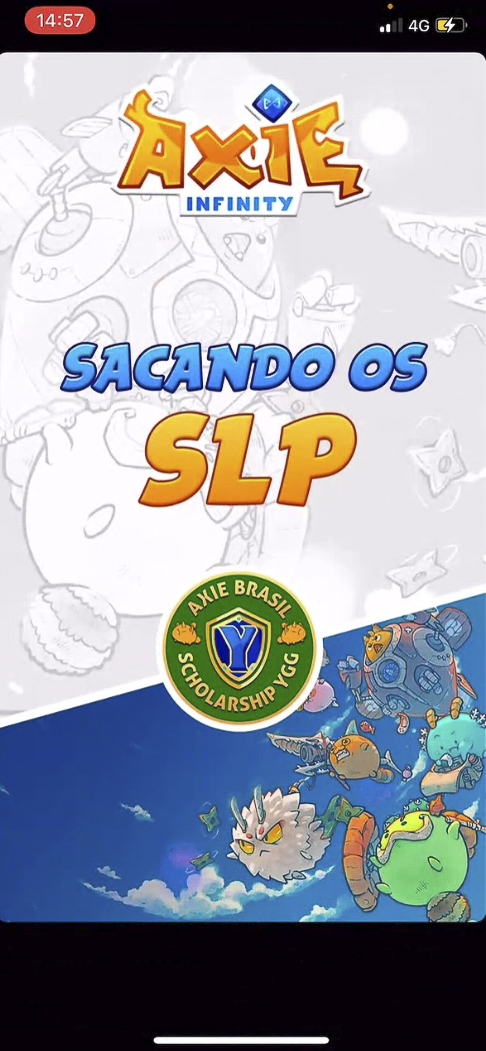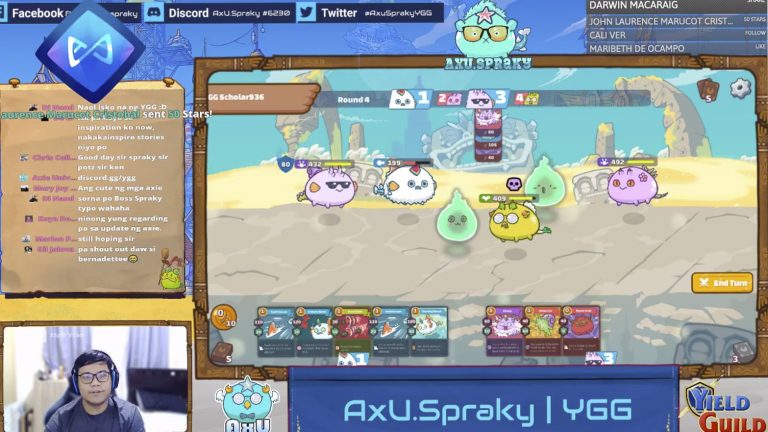The Philippine province of Nueva Ecija is known for its vast expanse of rice fields, framed by uninterrupted sky. Here, 31-year-old RK Secretario spent more than two years selling rice feed to poultry farmers. These days, though, he makes his living by playing a Vietnamese smartphone game.
Things had been hard enough before the pandemic, with agriculture at the mercy of typhoons and floods. When harsh lockdowns restricted movement, it became almost impossible, Secretario told Rest of World. As the pandemic stretched on, he grew anxious. He was the sole caretaker of his 82-year-old grandmother; how was he expected to support both of them?
Before a friend referred him, he’d heard talk of Axie Infinity: an online, blockchain-based game where players can earn tokens and cash out in local currency. Within a few months, Secretario had plunged into a world of brightly colored mystical creatures and daily quests, his instinct for the game’s mechanics quickly kicking in from years of joining role-playing games.
An hour’s play per day now nets him nearly double the income of his feed sales job — about $2,000 (100,000 Philippine pesos) last month. The rest of the time, he looks after his grandmother. He doesn’t question the game’s utility, nor the in-game demand that generates real money for him, calling it a “blessing.”
“It’s really, really, really hard to find a regular job, especially in our province,” he told Rest of World. “Axie pays better, and it’s more safe to stay at home.”
Not only is Secretario one of over a million players who have flocked to the game over the past year, he is part of an increasingly elaborate outsourcing structure that has sprung up around it. Players like him are often sponsored by managers or guilds, who fund their entry into the game — a high barrier, with current costs that can go upwards of $1,500 — in return for a cut. Crypto-denominated earnings are made by cultivating in-game creatures called Axies, which can be battled or sold at a profit to other players. Guilds can sprawl hundreds of members managing various accounts, honing Axie characters and churning the value of the Axies Infinity Shard token ever higher.
Axie is both a play-to-earn game and an entire NFT-based economy, and its soaring popularity is partly down to chance. Lockdowns in the Philippines and elsewhere have forced many into irregular work. Workers in Venezuela, the game’s second-largest market, have shifted from finding outsourcing jobs on microtasking platform Remotasks to games like Axie Infinity, Rest of World reporting has found. Users from these two countries make up between 45% and 50% of Axie’s player base.
Combined with exuberance in cryptocurrency markets and the low barrier to entry for mobile gaming, Axie and its play-to-earn peers are riding a wave of eager labor.
“At the moment, there are many more [people that want to play] around the world than there are in assets to go around,” said Leah Callon-Butler, a director of the consulting group Emfarsis, which has produced market analysis for the Axie Infinity community in the Philippines.
Secretario echoed the same idea. “Everyone I know is trying to play,” he told Rest of World.
Created by Vietnamese company Sky Mavis in 2018, the game principles of Axie Infinity feel familiar. The game was inspired by CryptoKitties, while the collecting, training, battling, and selling of Axies follows a model similar to the game Pokémon Go combined with turn-based elements that mirror Blizzard Entertainment’s Hearthstone.
An Axie is a nonfungible token (NFT), meaning each is unique and irreplicable. Extremely rare Axies are considered collectors’ items and can go for more than $1 million dollars — though most players handle more common Axies, which sell for a (still-steep) several hundred dollars.
By battling Axies and completing quests, players earn rewards in the form of one of two Ethereum-based cryptocurrencies — in-game token Smooth Love Potions (SLP) and governance token Axie Infinity Shards (AXS). With SLP and AXS, players can breed their Axies to create more (which they can choose to sell) or buy virtual land within the game. Each plot of land is, naturally, an NFT as well.
Some in the industry optimistically see blockchain-based games like Axie as a labor alternative to the Philippines’ massive, existing outsourcing industries.
“If you can make more than what you’d make in a BPO [business process outsourcing] office somewhere playing a game, why wouldn’t you?” Rockwell Shah, an entrepreneur who recently moved into the sector by starting his own guild, told Rest of World.
As more people clamor to enter the game, the cost barriers have risen. A player needs to first buy three existing Axies, of which there are a limited quantity. Higher-quality teams cost more but yield more SLP and AXS. In November last year, when Axie had only around 7,500 players, it cost around $300 to buy into the game; by this summer, that had risen to $1,500.
Polsan Pangindian, in Manila, had built a comfortable income from various investments, including a chain of seafood restaurants in the Philippines and some cryptocurrency holdings. It gave him the capital — and the confidence — to buy a team. “Luckily, I was able to save up enough money before the pandemic and decided to invest in Axie,” he told Rest of World.
“I started with three teams. When my first three teams finally generated a good amount of revenue, I started buying more,” he said. Pangindian is business-minded and has already marked his revenue tipping point. He’s invested about $16,000 so far, and predicts he’ll see a profit from his latest six teams within one to two months.
For the many who can’t afford to buy into the game on their own, a sponsorship market has developed in “scholarships.” Pangindian, for one, has backed several “scholars” by providing them the Axies for their first team. He now has nine scholars, and manages them for a 50%–60% cut of their earnings as they battle Axies.
Manila native Jake Nool, 28, who has been piloting a team for Pangindian for two months, seems incredulous at the profits he’s made from playing. It’s paid for his rent and utilities.
“I’ve heard bank employees tell me the game is a scam. But there I was, encashing my SLPs,” he said. “I want to buy my own Axie team or invest the money for other enterprises I have planned.”
Pangindian operates on the lower end of industrial-scale player operations, though. At the other end is Yield Guild Games (YGG), a Philippines-based players’ guild managing some 4,700 Axie Infinity scholars.
YGG has bought a host of Axies, which it loans out to players to battle and grow; its scholars keep 70% of the in-game rewards and don’t have to front the money to buy their own teams, YGG co-founder Beryl Li told Rest of World. YGG retains ownership of the Axies and the right to breed them. Secretario, the former poultry feed salesman, is among them.
“We don’t sell any of the Axies we breed,” Li said. “We save them all to loan out to even more scholars.”
Guilds support the game’s seemingly ever-swelling player base, and YGG has sped up its growth by absorbing players with scholar bases of their own.
Venture capital fund Delphi Digital has invested in both YGG and developer Sky Mavis. Speaking to Rest of World, Delphi co-founder Yan Liberman described the fund’s investment in the guild as one that ensured a steady onboarding of users, and as a route into the expansion of the whole play-to-earn ecosystem. YGG announced on Thursday, August 19, that it had raised another $4.6 million from Andreessen Horowitz VC firm a16z “to establish blockchain-based play-to-earn as the next major innovation in gaming and dominant business model within the industry.”
AXS is becoming a governance token, too, Liberman pointed out, which “allows everyone to be … much more ingrained in the game, in the community.” With these tokens in the hands of players, the ecosystem’s growth can be influenced by Axie’s community in a way few other games can claim.
Sky Mavis did not respond to requests for an interview.
YGG and others sell Axie Infinity as a way for players, many in the Global South, to earn the kind of money that could be life-changing. But accessing the game is increasingly difficult.

Several would-be players in the Philippines and Venezuela told Rest of World they were desperately searching for guilds or managers to sponsor them. In Facebook groups, on Twitter, Instagram, and on Discord, prospective players post their contact information and details that prospective managers might find useful: locations, the hours they can play per day, the strength of their internet connection.
“We just started our guild about two months ago,” said the entrepreneur Shah. He founded the Las Vegas–based Starship Guild, which currently has over 500 scholars. “Every time we Tweet out that we have 50 scholarships available, we have hundreds of people on the waiting list.”
Ever the salesman, Secretario has begun using his earnings to buy up Axie teams and resell them to others looking to enter the game.
While the buy-in barrier is high, believers see Axie Infinity, and similar games like CryptoBlades and The Sandbox, as lowering the barriers for nonprofessionals to dabble in crypto. Guilds help shield them from making a direct investment, said Sasha Fleyshman, an analyst at investment firm Arca. “If the game didn’t exist tomorrow, these players that came in, they didn’t lose money,” he said. “They maybe lost a little bit of time. They lost sweat equity.”
For his part, Secretario is willing to focus on the fact that he is earning and employed, and to ride the Axie wave as long as it lasts. The extra money has allowed him to run charity events in his community for the pandemic-affected. “It’s not just for monetary consideration — I enjoy playing the game as it is,” he said. “I believe the founders are doing their best to make sure this play-to-earn movement exists for a long time.”



